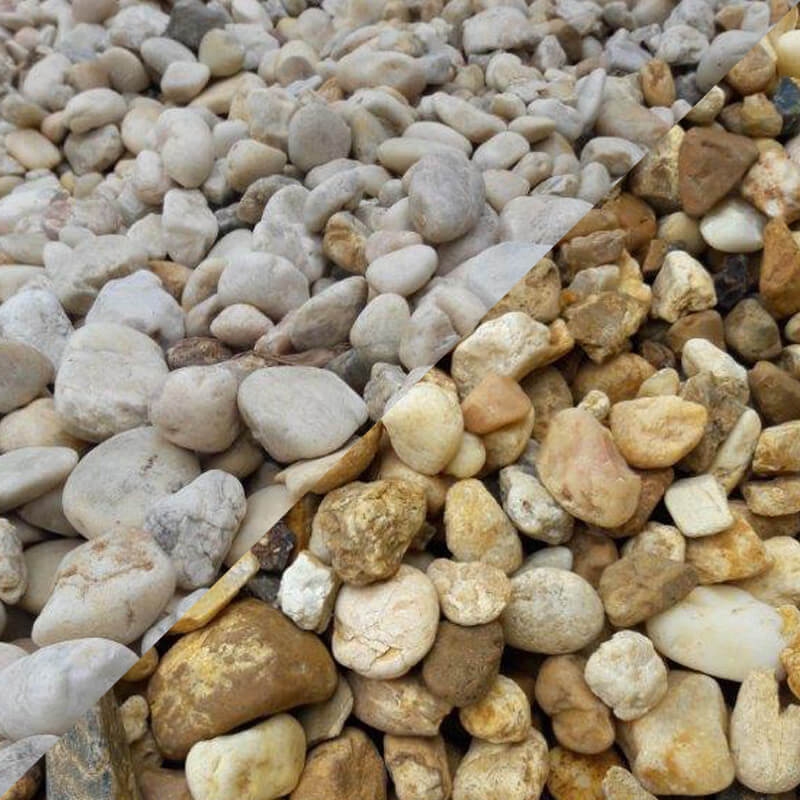
How to decide between Brown River Rock & White River Rock
Share
Choosing Between White and Brown River Rock for Your Landscaping Design: A Complete Guide
When it comes to landscaping, the choice of materials plays a crucial role in defining the aesthetic and functionality of your outdoor space. Among the many options available, white and brown river rock are two popular choices that can transform a garden, pathway, or yard into an inviting, natural retreat. However, knowing when and how to use each type can be a challenge. We’ll dive into the pros and cons of white and brown river rock, and guide you on how to incorporate them into your landscaping design.
Understanding River Rock
River rock is smooth, rounded stones typically found in riverbeds. Their natural finish and variety of colors make them a popular choice for landscaping projects. They are versatile, durable, and low-maintenance, making them a great long-term investment.
Now, let’s look at the specifics of white and brown river rock and when to use each.
1. White River Rock: Clean and Modern Elegance
White river rocks are typically used to create a sleek, bright, and minimalist look. Their light color reflects sunlight, which can make spaces feel open and fresh. Here’s how and when to use them in your landscaping design:
When to Use White River Rock:
- Contemporary Landscapes: White river rocks are perfect for modern and minimalist designs. Their clean look fits well with linear, geometric landscaping styles.
- Accent Areas: Use white river rocks to highlight key elements of your garden, like water features, sculptures, or focal plants. Their neutral tone allows other design features to stand out.
- Low Light Areas: White rocks can brighten up shaded areas or dark corners, creating a more balanced and visually pleasing landscape.
- Mediterranean and Coastal Gardens: If you’re going for a Mediterranean or beach-inspired design, white river rock can mimic the look of sun-bleached stone, adding to the overall aesthetic.
How to Use White River Rock:
- Around Plants: Surrounding plants with white river rocks creates a striking contrast, especially with vibrant greens or colorful blooms.
- Pathways and Walkways: White rocks are great for defining paths and walkways, giving them a crisp, clean edge.
- Mulching Alternative: White river rocks can be used as an alternative to traditional mulch in garden beds. They provide better drainage and won’t break down over time.
Things to Consider:
- Heat Reflection: White river rocks reflect sunlight and can make surrounding areas hotter during sunny days, which may not be ideal for all plants.
- Cleaning: These stones can become discolored over time if they gather dirt or algae, requiring periodic washing to maintain their bright appearance.
2. Brown River Rock: Warm and Natural Appeal
Brown river rocks come in earthy tones like brown, tan, and rust, which add warmth and natural texture to any landscape. They blend seamlessly into the environment, making them ideal for a more rustic or organic design.
When to Use Brown River Rock:
- Naturalistic Designs: Brown river rocks are perfect for designs that mimic nature, such as woodland gardens or desert-inspired landscapes.
- Large Outdoor Spaces: If you’re working with a larger area, brown river rock can add warmth and help blend different sections of the landscape.
- Rustic or Traditional Gardens: If your home or garden leans toward a rustic or traditional aesthetic, brown river rocks provide a more subtle and natural look.
- Water Features: These rocks complement ponds, streams, or dry river beds beautifully, enhancing the natural look of water features.
How to Use Brown River Rock:
- Water Features and Ponds: Brown river rocks are often used in water features because they blend in with natural surroundings. They give the water a more earthy, serene vibe.
- Dry River Beds: Using brown river rock in dry river bed installations is a great way to simulate a natural stream while improving drainage and erosion control.
- Mulching in Large Areas: Brown river rock works well as mulch in large garden beds, creating a harmonious look that doesn’t overpower the rest of the landscape.
Things to Consider:
- Color Fading: Over time, brown river rocks may fade, especially in direct sunlight. The rocks may need occasional replacement to maintain their rich color.
- Blending with Plants: While brown rocks blend well with the earth, be mindful of the plant colors around them. Brown tones can sometimes dull the visual impact of plants, especially if they are similarly colored.
Making the Right Choice for Your Landscape
So, how do you choose between white and brown river rock for your landscaping?
- Style and Aesthetic: Consider the overall theme of your outdoor space. For modern and minimalist designs, white river rock is ideal. For more natural, rustic, or traditional landscapes, brown river rock will seamlessly fit in.
- Location and Functionality: Think about where you will be placing the rocks. White river rock is perfect for brightening up shady areas or serving as a clean backdrop, while brown river rock blends beautifully in natural settings or around water features.
- Maintenance: White river rock requires more cleaning to maintain its bright appearance, whereas brown river rock is better at hiding dirt and debris.
Ultimately, the decision between white and brown river rock depends on the look you want to achieve, the functionality required, and the maintenance you’re willing to perform. By understanding the unique properties of each, you can make a choice that enhances your landscape for years to come.
